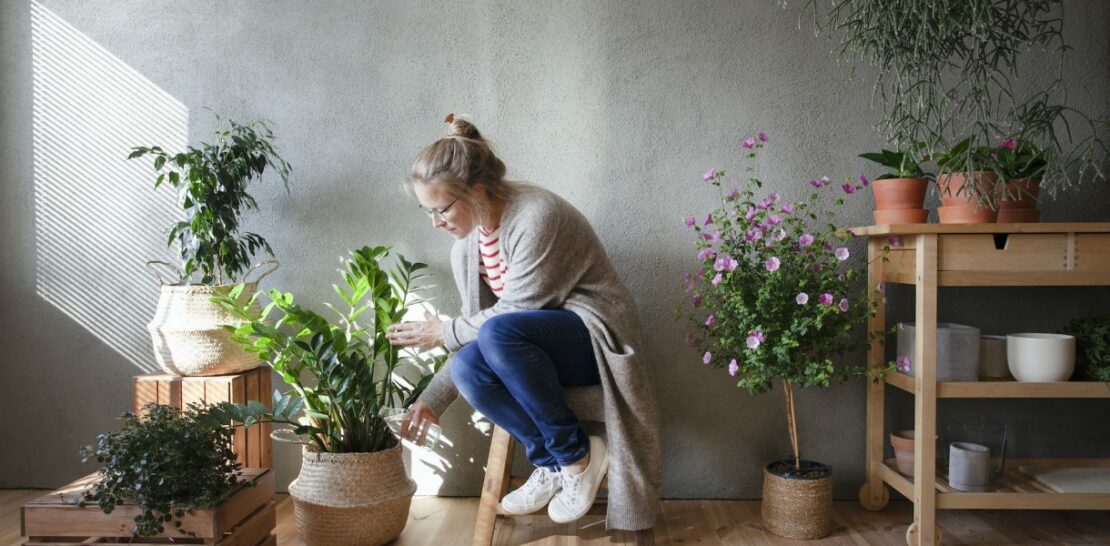Welcome, plant enthusiasts and fortune seekers!
As a specialist in the English language, I am delighted to present an exhaustive exploration into the realm of houseplants believed to bring luck, prosperity, and positivity into your home.
In this comprehensive article, we will dive deep into the folklore, history, and practical aspects of these five fascinating plants, and offer guidance on how to incorporate them into your daily life.
1. Money Plant (Epipremnum aureum)
Leading the list of these auspicious flora is the Money Plant, also known by its scientific name, Epipremnum aureum. This versatile and hardy houseplant serves as an emblem of wealth and prosperity. Let’s examine the different aspects that contribute to its fame as a harbinger of good fortune:
- Folklore and Beliefs: Originating in Southeast Asia, the Money Plant has long been revered for its ability to attract wealth and success. The Chinese practice of Feng Shui, which emphasizes the arrangement of elements to promote harmony and balance, values this plant for its round, coin-like leaves, symbolizing money and abundance. Additionally, its ever-growing vines represent continuous growth and accumulation of wealth.
- Care and Cultivation: This low-maintenance plant thrives in well-drained soil, bright indirect light, and moderate humidity. It can be grown as a hanging plant, potted plant, or even trained to climb a trellis or support. With proper care, this verdant symbol of prosperity will flourish and bring its positive energy into your home.
- Benefits and Uses: Besides its reputation for attracting wealth, the Money Plant is also known for its air-purifying qualities. It effectively removes common household toxins, such as formaldehyde and benzene, improving the overall air quality and well-being of your living space.
With its rich cultural significance, easy care requirements, and health benefits, the Money Plant is an ideal addition to any home seeking a touch of good fortune.
2. Lucky Bamboo (Dracaena sanderiana)
Next on our journey of fortuitous flora is the ever-popular Lucky Bamboo, or Dracaena sanderiana. This elegant plant is steeped in symbolism and tradition, making it a beloved choice for those looking to invite luck and prosperity into their lives.
Symbolism and Significance: Lucky Bamboo is an essential element in Chinese culture and has been cultivated for over 5,000 years. Its resilience and ability to grow in various conditions is seen as a reflection of a strong and persevering spirit. The plant’s vertical growth is associated with upward progress and reaching for higher aspirations.
In Chinese tradition, the number of bamboo stalks gifted or displayed holds specific meanings:
- One stalk symbolizes simplicity and a focused life.
- Two stalks represent love and companionship.
- Three stalks signify happiness, wealth, and long life.
- Five stalks embody the five areas of life that bring wealth: emotional, spiritual, mental, physical, and intuitive.
- Seven stalks indicate good health and a strong connection to the universe.
- Nine stalks represent great luck and a prosperous life.
- Ten stalks symbolize completion and perfection.
Growth and Maintenance: Lucky Bamboo is a low-light tolerant plant that can thrive in water or soil. It requires minimal care and can be easily shaped and manipulated by placing it in different containers or using wires to guide its growth. This adaptability allows you to create your own unique display that represents your personal aspirations and intentions.
3. Jade Plant (Crassula ovata)
Moving forward, we encounter the beautiful and hardy Jade Plant, scientifically known as Crassula ovata. This succulent is cherished not only for its ornamental value but also for its reputation as a magnet for luck and financial success.
A closer look at the Jade Plant reveals the following elements that contribute to its auspicious nature:
- Mythology and Symbolism: Hailing from South Africa, the Jade Plant has been adopted by many cultures as a symbol of prosperity. Its plump, round leaves are reminiscent of jade stones, which are highly valued in Chinese culture for their beautyand association with wealth. The plant’s ability to store water in its leaves is seen as a metaphor for the accumulation and retention of financial resources.
- Aesthetic Appeal and Versatility: With its attractive, fleshy leaves and branching structure, the Jade Plant adds a touch of elegance and charm to any living space. It can be displayed as a small tabletop plant, a larger potted specimen, or even as a bonsai, showcasing its adaptability and timeless beauty.
- Propagation and Growth: The Jade Plant is known for its ease of propagation, as a single leaf or stem cutting can quickly grow into a new plant. This characteristic has led to beliefs that owning and sharing Jade Plants can multiply one’s fortune and foster an atmosphere of abundance and generosity.
- Cultivation and Care: As a succulent, the Jade Plant prefers well-draining soil, bright light, and infrequent watering, making it a low-maintenance option for busy households. Its resilience and hardiness further solidify its status as a symbol of strength and prosperity.
By incorporating the Jade Plant into your home, you can enjoy its visual appeal and positive energy as it works to attract wealth and success.
4. Rubber Plant (Ficus elastica)
Another esteemed member of the prosperity-attracting plant family is the Rubber Plant, or Ficus elastica. This bold and striking houseplant is known for its large, glossy leaves and robust growth, as well as its association with abundance and good fortune.
Let’s delve into the various aspects that make the Rubber Plant a popular choice for those seeking to cultivate prosperity:
- Historical Significance: The Rubber Plant’s roots can be traced back to ancient India, where its sap was once used to make rubber. As a valuable and versatile resource, the plant became synonymous with wealth and abundance. Its large, sturdy leaves are also believed to symbolize the ability to withstand challenges and provide shelter and protection.
- Placement and Design: In the practice of Feng Shui, the Rubber Plant is said to bring positive energy when placed in the southeast corner of a room, which is associated with wealth and prosperity. Its bold appearance and deep green leaves can serve as a focal point or enhance existing decor, making it a versatile addition to any space.
- Growth and Care: The Rubber Plant is a relatively easy houseplant to care for, requiring bright, indirect light and well-draining soil. It can grow quite large over time, further emphasizing its association with abundance and continual growth.
- Air-Purifying Abilities: In addition to its auspicious reputation, the Rubber Plant is also known for its ability to improve indoor air quality. It effectively filters out common pollutants, such as formaldehyde and benzene, contributing to a healthier and more positive living environment.
By incorporating the Rubber Plant into your home, you can enjoy its captivating beauty while reaping the benefits of its luck-attracting properties.
5. Pachira Aquatica (Money Tree)
Rounding out our list of fortune-bringing flora is the enchanting Pachira aquatica, commonly known as the Money Tree. This unique and visually striking plant is believed to bring prosperity and good fortune to its owner, making it a popular choice for both home and office settings.
Below are the various facets that contribute to the Money Tree’s reputation as a symbol of wealth and luck:
- Folklore and Origins: The Money Tree’s legend originates from a tale in ancient Taiwan, where a poor farmer discovered the plant and cultivated it, eventually becoming wealthy from selling the seeds. This story led to the belief that the Money Tree can attract financial success and good fortune.
- Symbolism and Design: The Money Tree is characterized by its unique braided trunk, which is said to symbolize the intertwining of the five elements in Feng Shui: wood, fire, earth, metal, and water. The harmony of these elements is believed to create a balanced energy that attracts luck and prosperity. Additionally, its palmate leaves are thought to represent the five fingers of a hand, further emphasizing the plant’s connection to the elemental balance.
- Care and Cultivation: The Money Tree is a low-maintenance plant that thrives in bright, indirect light and well-draining soil. It prefers a humid environment and can be easily cared for with regular watering and occasional misting. Its adaptability and easy care make it an excellent choice for those seeking to invite luck and abundance into their lives without the added stress of complicated plant care.
- Uses and Applications: The Money Tree is often utilized in both home and office settings to create a focal point or conversation piece while simultaneously promoting a positive energy flow. It is also a popular gift, as it represents a wish for the recipient’s prosperity and success.
Incorporating the Money Tree into your living or work environment can serve as a constant reminder of the interconnectedness of the elements and the potential for growth, prosperity, and good fortune in your life.
In conclusion, the cultivation of these five auspicious houseplants offers a unique opportunity to blend beauty, tradition, and positive energy into your daily life. Through the careful selection and placement of the Money Plant, Lucky Bamboo, Jade Plant, Rubber Plant, and Pachira aquatica, you can create an environment that fosters luck, prosperity, and overall well-being. Remember that, as with any living thing, these plants require attention and care. The more you nurture and appreciate them, the more you will be able to tap into their potential to attract good fortune and abundance into your life. Happy planting, and may good luck and prosperity bloom in your home!




